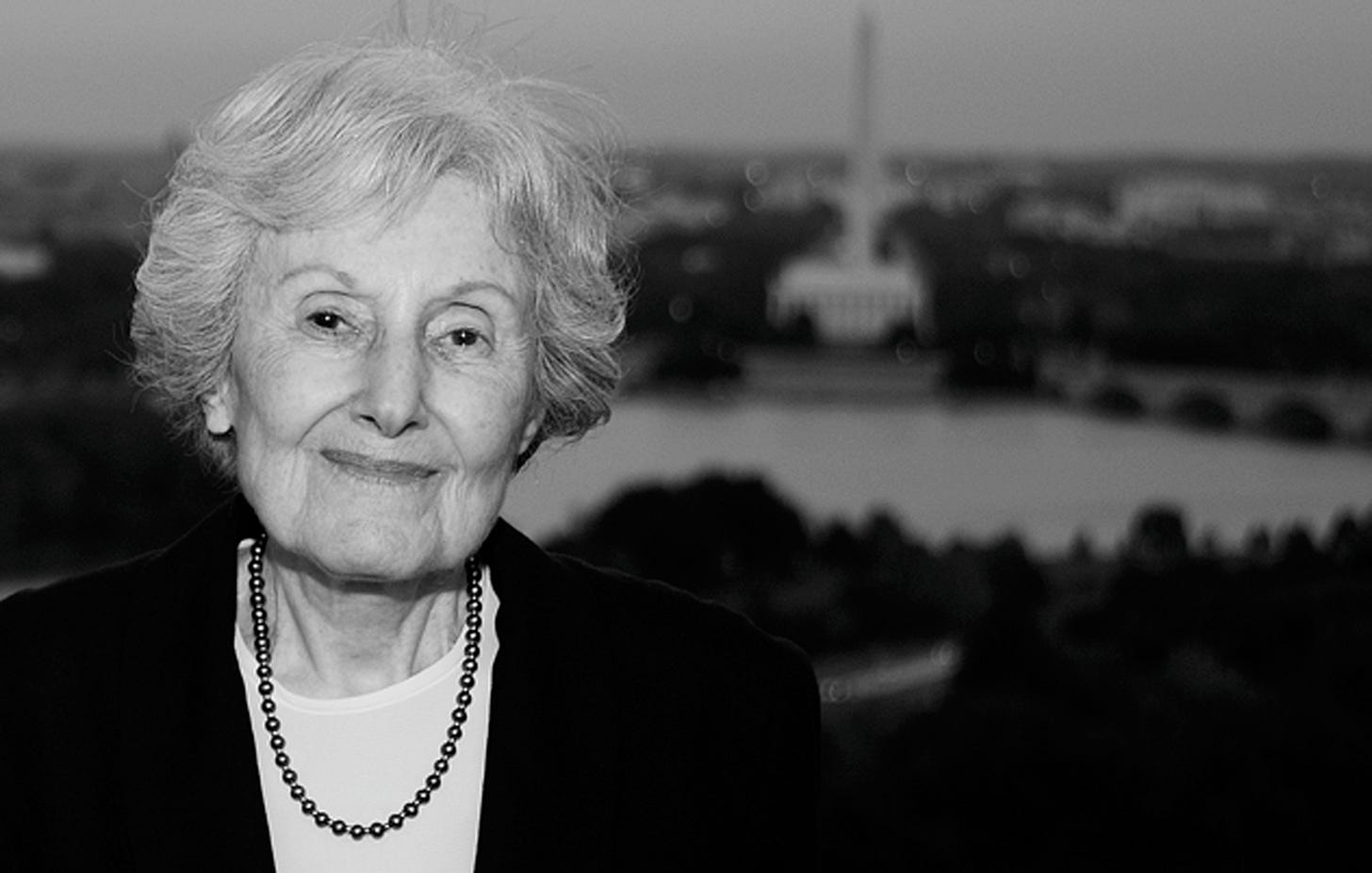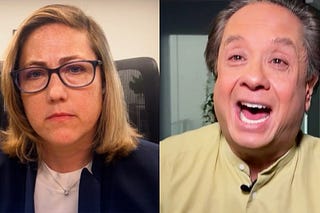
Gertrude Himmelfarb, a historian who helped resuscitate the reputation of the Victorians and a public intellectual who shaped neoconservatism, died this week at the age of 97.
In a writing career astonishingly long—some seven decades separate her first and final publications—Himmelfarb revealed the complicated ways in which ideas and culture influence one another. And, as she showed in profiles of such figures as Burke and Bagehot, Malthus and Mill, often the best way to understand ideas and culture is through biography, with its untidiness of context and character and contingency.
The revisionist portrait of the Victorians that Himmelfarb painted was far subtler than the popular caricature. We tend to think of the Victorians as pompous prudes. Or as the vain hypocrites whose pretensions Lytton Strachey punctured. Or as the denizens of Dickens’s grim, gray London. But Himmelfarb’s Victorians were passionate seekers, arguing and stumbling their way toward answers to difficult questions: How can we best care for the needy and the sick? How should we prevent crime and punish criminals? How can we cope with the social and economic consequences of rapid technological change? How should the sexes live together? How can we work out the tensions between liberty and democracy? How, in the face of unsettling scientific discoveries, are we to understand ourselves and our place in the world?
All these moral and political questions demand answers of us, too. By explaining the Victorians’ attempts to answer them, Himmelfarb’s many books and essays help us to think more clearly about both the questions and our own answers.
Himmelfarb was born in Brooklyn in 1922, the second child of Russian Jewish immigrants most comfortable speaking Yiddish. “My parents had no formal education at all, but it was understood from the very beginning that both my brother and I would go to college,” she said in a 1995 C-SPAN interview:
It was an enormous respect for learning . . . an enormous respect for the book. There was a tradition among Jewish families, and mine was a rather observant Jewish family . . . that when a book of the Bible or the prayer book fell on the floor, you kissed it when you picked it up in order to preserve its kind of purity. I must say, that respect for the book transferred itself to secular books as well. I’m not suggesting that we kiss secular books when we—we’re rather hard on books, in that we annotate them wildly and so on—but there was that respect for the book. There was a respect for learning.
She studied history, philosophy, and economics at Brooklyn College, while also taking classes—as her older brother Milton Himmelfarb had—in Hebrew literature at the Jewish Theological Seminary.
In 1940, she met Irving Kristol, also a Brooklyn-born child of Russian immigrants, at a gathering of the Young People’s Socialist League. She was 18; he was 20; they were both Trotskyists. Kristol described their courtship in a 1995 autobiographical memoir:
At these meetings I noticed a girl . . . who sat quietly at the other end of the small room. Her name was Gertrude Himmelfarb, but she was called “Bea.” She had a trim figure and a strong, handsome face that radiated intelligence and sensibility. I noticed her for some weeks before approaching her and asking her out. In truth, I was already in love with her without even knowing her. She said “yes” quietly. And so we “went out,” which is to say we went to the Saturday night movies . . . and saw only foreign movies since we were cultural snobs.
Six weeks after Pearl Harbor, Himmelfarb and Kristol were married. They would raise two children—William Kristol and Elizabeth Kristol Nelson—and enjoy a long and fruitful intellectual partnership: She advised him on his magazines and other projects, he helped her edit and think through her many books.
Himmelfarb and Kristol had been among the junior associates of the busy, buzzy “New York intellectuals”—the literary critics and political writers, mostly a generation older and mostly big-egoed, associated with Partisan Review. Some of that set, like Lionel and Diana Trilling, would remain their friends for decades. Himmelfarb and Kristol would each write for Partisan Review, but they were more at home in another new “little magazine,” Commentary, where Himmelfarb was a frequent contributor and Kristol was for several years an editor.
Meanwhile, when Himmelfarb interviewed at the University of Chicago for graduate school, her interviewer warned her that “you have three strikes against you,” as she later recalled. “You will never have a teaching job. If you’re entering this program with the expectation of teaching in a university, I want to disabuse you of that. That’s not going to happen.” Strike one: She was a Jew. Strike two: She was a woman. Strike three: She was a New Yorker, “and midwestern colleges had a strong bias against easterners.”
That interviewer, the distinguished historian Louis Gottschalk, who would go on to be Himmelfarb’s mentor at Chicago, was wrong about her teaching career, although maybe not about the geography: She would become a professor and teach for more than two decades at the City University of New York, including Brooklyn College.
Himmelfarb did not set out to become an authority on the Victorians. “It is with some awe,” she would write, that Americans view the tangled lives and ideas of the Victorian intellectuals. Besides, it wasn’t obvious in the 1940s that there was much left to write about them, since they had written so voluminously about themselves. And a clear-eyed historical assessment was made more difficult by the fact that the Victorian era was not far from living memory—indeed, the last of the late Victorians, such as Winston Churchill and Bertrand Russell, were still active in politics and letters.
It was while working toward her master’s degree in history, with a thesis on Rousseau and the French Revolution, that Himmelfarb first became fascinated by a Victorian intellectual—Lord Acton, the Cambridge historian who had delivered uneven lectures on the revolution. Here was a puzzle: A man of astonishing erudition, fluent in several languages and possessed of a library of some 60,000 volumes, Acton was remembered by posterity only for epigrammatic gems dug out of his scattered lectures and letters—most famously the phrase “Power tends to corrupt, and absolute power corrupts absolutely.”
Himmelfarb picked Acton as the subject of her doctoral dissertation. She and Kristol spent part of 1946-47 on a fellowship in Cambridge, where, Kristol would recall, “food was still stringently rationed” and the winter was uncommonly cold: “Poor Bea, who had developed chilblains, had to wear gloves when she worked on the Acton papers lest her bloody fingers stain them.” She edited and in 1948 published a collection of Acton’s writings, and in late 1950 submitted her dissertation.
Himmelfarb explained how Acton’s character had caused his professional tragedy: After decades of labor, he never completed his ambitious History of Liberty—or any other book—because he was too much a perfectionist, too much a completist, too easily drawn into other time-consuming projects.
But Himmelfarb’s goal was to produce “not a biography of a life but the biography of a mind.” Acton, she wrote, was a man of his own times yet in a sense also “one of our great contemporaries,” an improbable combination of a “high moralist and man of the world.” On the great subjects that occupied him—politics and religion, liberty and morality—his ideas evolved as he aged. In his twenties, he had admired Edmund Burke’s un-idealistic conservatism; by his forties, he had begun to embrace natural law and ideal politics. A devout Catholic, he found odious the notion of papal infallibility. (It was in the context of a debate about the papacy that he wrote his famous “power corrupts” line.) Once convinced that liberty and morality were inseparable from religion, in time he came to see moral wisdom in George Eliot’s brand of atheism.
Acton was a conservative liberal, a liberal conservative, and a deeply pessimistic optimist. He may have been doomed to leave his magnum opus unfinished, but his thoughts, with their seeming paradoxes intact, at last appeared in book form when Himmelfarb’s judicious dissertation was published in 1952.
Kristol and Himmelfarb spent much of the 1950s in England, where he was busy launching and editing the monthly journal Encounter. As a result of Himmelfarb’s Acton biography, “she was of interest to the British,” Kristol recalled. The couple befriended British conservative thinkers, including Malcolm Muggeridge and Michael Oakeshott, as well as several “older Jewish ex-radicals.”
Busy though the couple was raising their two small children—being able to afford an au pair helped—Himmelfarb still tackled her next big project, an intellectual biography of Charles Darwin and an account of how his ideas were received. Published in 1959, the centennial of On the Origin of Species, Himmelfarb’s Darwin book is that rare thing: a 400-pager that feels half as long. Aspects of her interpretation of evolutionary theory have justifiably been criticized, but the book remains a wonderful introduction to the Victorian debate over Darwin’s ideas.
A description that Himmelfarb pinned on Lord Acton—“an unsystematic although profound thinker”—could be applied to her, too. She was certainly profound; her Acton and Darwin books are evidence enough of that. And she was unsystematic in two senses. First, she was suspicious of systematic new approaches to historical scholarship, like using social-science methodologies or focusing narrowly on race, class, or gender. As she argued in The New History and the Old (1987), these approaches, when taken to extremes, turn history into ideology.
Second, Himmelfarb was unsystematic in that her writings did not unfold according to a grand plan. She was guided by her shifting interests, and by the opportunities of reviewing books for Commentary, The New Republic, and The American Scholar. Several of Himmelfarb’s books are largely made up of these review-essays, including the dozen or so biographies in The Moral Imagination (2006), each a glimmering mother-of-pearl cameo.
Among Himmelfarb’s many learned books on the Victorians and their forebears and successors, the finest is the two-volume work The Idea of Poverty (1983) and Poverty and Compassion (1991). She critiques Malthusianism—the “de-moralized” economics that Dickens famously put in the mouth of Ebenzer “decrease the surplus population” Scrooge. She explains the evolution of Victorian thinking about the poor, morality, and reform. And she pinpoints the origins of concepts we take for granted, such as the “poverty line.” These two books are an extraordinary achievement, showing Himmelfarb’s considerable powers in peak form.
The concluding lines of Poverty and Compassion could respectably serve as a summary of much of Himmelfarb’s body of work:
The Victorians have no solutions for our problems, if only because their problems are not ours. Today it requires a strenuous exercise of the moral imagination to recover the sensibility that came so naturally to them. To make that effort, to try to understand them as they understood themselves, is to understand ourselves better than we have done of late.
It is worth taking a moment to discuss Himmelfarb’s writerly craft and style.
When reading the work of some historians, it is obvious that they have put everything they have learned into the book or article, cramming in every last morsel of fact and wafer of conjecture. They lack the judgment or confidence to hold back.
That was not Himmelfarb’s way. When reading her work, you get the sense that just a fraction of what she knew made it into print, that there are hidden depths to her knowledge and analysis. What does show up on the page is evenhanded and prudently caveated.
As could be expected of an inveterate reviser—“I rewrite constantly, compulsively”—her prose is precise and tightly controlled, but still inviting. She never indulges in flamboyance. And her wit is cracklingly dry. (A notable exception is a hilarious short piece lamenting the decline of the footnote, and even that argument is only partly playful.)
It may be that her eminently clear writing style owed something to the negative example of Lord Acton, who for many years wrote only for fellow academics, producing work “absolutely unintelligible” to ordinary readers, as Himmelfarb noted in her dissertation.
I don’t know if it’s unfair to Acton to say that his scholarly prose revealed something about his character. But as a longtime reader, one-time editor, and friend of Himmelfarb’s, I can say that the elegance and exactness of her writing revealed a great deal about her character.
In a provocative 2014 article in National Affairs, Jonathan Bronitsky argued that Gertrude Himmelfarb was more central to the origins of neoconservatism than is generally understood. Long before Irving Kristol cofounded The Public Interest in 1965, he was learning from, and thinking alongside, his wife—about Burke and Smith and liberty and society and human nature. “I am astonished how intellectually twinned Bea and I have been over the years,” Irving would later write, “pursuing different subjects while thinking the same thoughts and reaching the same conclusions.”
The influence of Himmelfarb’s ideas on neoconservatism, and conservatism more generally, was readily apparent by the 1980s and ’90s. Although she rarely wrote about contemporary policy, her examination of the virtues prized by the Victorians and her concern about the “de-moralizing” of our own day shaped generations of conservative thinkers, writers, and policy analysts.
In 1987, the Kristols retired from teaching and quit New York for Washington, D.C., not only for reasons of family and friends but because “New York intellectual and cultural life,” as Irving put it, was becoming “ever more parochial and sterile,” while Washington “has witnessed a surge of intellectual vitality” and “inches along toward greater hospitality toward the life of the mind.” In this new scene and stage of life, Himmelfarb became more productive, publishing books and essays at a rapid clip all through the 1990s.
After Irving died in 2009, and even into her nineties as health ailments increasingly confined her to home, Himmelfarb continued to write—and I got a chance to work with her. In 2014, she wrote a piece, short and sharp, about Thomas Henry Huxley for the quarterly journal I edited, The New Atlantis. Like everybody else running little magazines, I kept in my head a list of writers I dreamed of editing; she had long been on it.
But then, unexpectedly, we became friends. I was told that Bea needed occasional tech support—nothing too tricky—and I volunteered so I could visit with her. Off and on over the next few years, I’d leave my office, stroll across town to her book-lined apartment, spend a few minutes fixing a Windows error or some printer problem, and then just sit for an hour listening and chatting. Bea was a wonderful conversationalist, strong of memory and formidable of opinion. We’d talk about Henry James and Jane Austen, Disraeli and Churchill, the New York intellectuals, the majesty of elephants, and—always this—little magazines: the best of yesterday and the need for better ones now.
We’d talk, too, about her old friends, like Lionel Trilling. In the introduction to one of her collections, Himmelfarb offered a touching tribute to her late friend. She noted his “seriousness about ideas that was not ‘academic,’” his “seriousness about public affairs that went beyond (or stopped short of) politics in the ordinary sense,” and his “moral gravitas.”
Himmelfarb was right to praise Trilling for these rare qualities. But she was wrong to say they were “uniquely his.” They were hers as well.
Gertrude Himmelfarb, Selected Essays
“The Elusive Woman Behind Thatcherism,” The Weekly Standard, February 2017
“The Jewish Question,” The Weekly Standard, June 2016
“Evolution and Ethics, Revisited,” The New Atlantis, Spring 2014
“Meet Mr. Bagehot,” The Weekly Standard, September 2013
“Reflections on Burke’s Reflections,” The New Criterion, February 2009
“Victorian Worthy,” The Weekly Standard, December 2005
“The Trilling Imagination,” The Weekly Standard, February 2005
“The Idea of Compassion: The British vs. the French Enlightenment,” The Public Interest, Fall 2001
“Democratic Remedies for Democratic Disorders,” The Public Interest, Spring 1998
“The Paradox of Thomas Carlyle,” The Weekly Standard, February 1997
“Victorian Values / Jewish Values,” Commentary, February 1989
“From Clapham to Bloomsbury: A Genealogy of Morals,” Commentary, February 1985
“In Defense of Progress,” Commentary, June 1980
“John Buchan,” Encounter, September 1960










